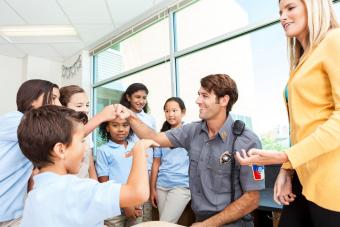
Learning to ride a bike is one of those time-honored milestones in most children's lives. While some still swear by the methods used decades ago, there are many modern methods for teaching kids of all ages to ride bicycles.
Training Wheels
Parents love this classic method because it takes the pressure off them to run in awkward positions. Children as young as age three can use bikes with training wheels. Avid cyclist, Sheldon Brown, shares the straight-forward instructions for this method, which involves coaching on pedaling and steering while the child tries out the skills in a comfortable way.
Pros
Children will feel more confident in their ability to ride independently since the training wheels keep the bike from tipping over, and the child is unlikely to fall as much.
Cons
Kids can develop a false sense of balance with the training wheels on their bike and could exhibit a higher level of fear about removing them as they get older. If training wheels aren't installed properly, they can cause kids to get stuck in small dips or ruts.

Glide Method
Biking experts from Bicycling.com recommend the glide method because it teaches proper balance and puts the kid in control. When starting this method, make sure your child can sit on the seat with both feet flat on the ground. Toddlers can use balance bikes on flat ground, but Bicycle Garage Indy says kids who have a lot of confidence, enjoy trying new things that are a little scary, and are older, like combining the glide method with a small, grassy incline.
- Have the child sit on the bike seat and walk their feet, keeping them on the ground all the time.
- Next, your child can try to push off the ground with his feet then raise each foot out to the side so it no longer touches the ground. Kids should try gliding like this until they can do it with ease.
- Kids can now try gliding with their feet resting on the pedals after they push off the ground.
- Once your child can balance for several seconds at a time consistently, teach them to use the pedals.
Pros
Kids get the chance to learn one or two biking skills--such as balance and steering--at a time instead of all at once.
Cons
The gliding method works best with balance bikes, which can cost families more since they'll need two bikes.
Towel Method
StartStanding.org suggests the towel method is the fastest way most kids can learn to balance on the bike, but it can be dangerous for the parent. Kids who already have some good balance and are trusting of the adult helper are ideal for this method.
- Grab a beach towel or sheet and fold it lengthwise so it is only about six inches wide.
- Place the center of the folded towel in the center of your child's chest. Pull it back under the child's armpits, then twist it behind their back for a snug harness-like fit.
- Hold the towel close to your child's body as they begin to pedal. Run alongside them holding the towel the entire time they're moving.
- Repeat this a few times on flat, straight surfaces so your child understands the correct feeling of balancing and pedaling at the same time.
- Once the child feels confident, remove the towel and just run alongside her.
Pros
Parents hold their children up in this approach, so it eliminates a lot of the anxiety about falling off the bike.
Cons
The adult helper has to run alongside the bike in an awkward position which could cause them to get hurt or fall and lose their child's trust.
Overcoming Obstacles
While every kid is unique, there are many common issues children face when learning to ride.
Fearful Rider
To help calm these fears of falling, start early. BikingExpert.com taking your toddler on bike rides with you using a child's bike seat so they start to get the feeling of balancing and tilting.
Trouble With Pedaling
Cycling experts from REI say pedal training starts with pedal awareness. Hold the bike steady while your child sits on it with eyes closed and raises knees up above the waist then uses his senses to find the pedals. Once your child is comfortable finding the pedals, start teaching him to pedal from a stopped position.
Helmet Hate
Some kids hate wearing helmets because they are uncomfortable, feel awkward, or look weird. BikingExpert.com says you should let your child pick out their own helmet, make sure it's the right size, and wear a helmet yourself whenever you ride.
Proper Braking
Whether your child will be using her feet, coaster brakes, or hand brakes The Sports Up suggests teaching braking before any other biking skills. This gives kids the opportunity to feel and experiment with the brakes.
The Thrill of Learning
Knowing your child, her bike, and the riding space you have available helps you decide which method is best. The right way to teach a child how to ride a bike is by using the approach that best works for her.







